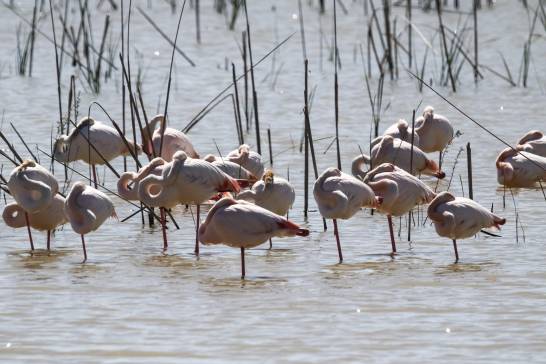lady is in mediterranean climate, with hot and rainy autumns and winters, hot and dry summers. However, in recent years rainfall levels have been below average. In the case of average temperature, the last few years have been slightly above the reference average.
The Singular Scientific Technical Infrastructure – Doñana Biological Reserve (ICTS-RBD), which manages the Doñana Biological Stationpresented the results of the Natural Processes Monitoring Program in the Natural Area of Doñana in the last three years.
This monitoring program periodically collects scientific data on the conservation status of Doñana and makes it possible to detect changes in ecosystems, such as the appearance of invasive species, the conservation status of threatened species or the wetlands themselves.
Specifically, for the species and population monitoring the program contains an important part dedicated to water birds, emblematic in Doñana, but also to flora, reptiles, amphibians, mammals and various species of invertebrates.
Water and land birds in descent
From the data obtained in recent years, the numbers obtained in the aerial survey of water birdsone of the oldest monitoring actions of the program, started in the 1970s and carried out monthly since then.
Thanks to this type of census, comparable data can be obtained between the years of the population size aquatic areas of the Doñana Natural Area, as well as distribution and evolution over time to detect threats and be able to propose improvements in use and management that allow their conservation.
“Within this series, the numbers obtained this year 2022 ended up being one of the lowest in the entire historical series, which includes almost 50 years, especially due to the very serious lack of rain that affected Doñana this winter. The total numbers achieved only 87,500 registered individualsfar from the little more than 470 thousand last year”, highlights a statement from the CSIC.
are also made land surveys of birds since the 1980s, as well as a control of its reproduction, which, although it started at the beginning of the Doñana National Park, was not carried out systematically until the beginning of this century. In this case, the marsh water conditions have a great influence on the birds’ reproduction. Especially important is the monitoring of endangered species, such as the Marbled teal or white-headed duck.
“The first shows a moderate decline from the peak reached in 2011. The second, although it has shown an upward trend since 2004, in the last two years it has shown a sharp decline. In fact, 2021 is the first year that no reproduction has been detected since 2004, when the time series began,” they say.
Aves Doñana/ Pixabay
The plight of the rabbit and endangered species
Mammals also have specific tracking performances. Since 2005 there have been wild boar and deer, as well as rabbits and hares. the rabbit has very low abundances in the last 10 years due to the combination of the effect of the two diseases that affect it and the impact of climate change on its ability to reproduce.
On the other hand, the seven species that most frequently inhabit Doñana (fox, mongoose, badger, lynx, wild or domestic cat, genet and otter) show large fluctuations from one year to the next and are generally in a good state of conservation.
“The fox is the most abundant, followed by the badger and mongoose, which have a similar abundance, a little less than the first. The populations of wild ungulates present in Doñana are in a good state of conservation”, they say.
As for reptiles, two Galapagos species native to Doñana, the leper tortoise and the European tortoise, since 2008 show a decrease in their relative abundance and an increase in the proportion of localities where they are absent. In addition, they face florida turtle competitionexotic species that has been the object of control actions for its eradication since the beginning of the 2000s.
In addition, Doñana is home to one of only two populations of spur tortoise from mainland Spain, considered critically endangered. The monitoring of terrestrial reptiles, including two of special interest for conservation, the Iberian endemism known as The Carbonell Lizard and the Ocellated Lizard, common in Doñana for much of the 20th century, experienced a sharp decline coinciding with that of the rabbit and from which its population has yet to recover. On the other hand, other species to be highlighted would be the long-tailed lizard and the red-tailed lizardwhich are showing a moderate decline in recent years.
Regarding amphibians, they are negatively affected by the water scarcity conditions of recent years.
Actions to contain invasive species
The monitoring program also has specific actions to locate and observe the evolution of invasive species present in Doñana, such as the Argentine ant, catfish or cruet.
As part of the program to control the invasion of the Argentine ant, the monitoring of ants in cork oaks is included. The observed trend of this exotic species continues to increase and a northward advance of the species has been detected.
Catfish, detected for the first time in 2009, maintains an upward trend and is mainly distributed in permanent water systems.
Regarding the cruet, detected for the first time in 2014 in the Doñana aviary and which showed an increase in the invaded area during the first years, it shows a decreasing trend in recent years, which confirms the effectiveness of the eradication measures carried out annually by the Natural Area. from Donana.
More information:
Program for Monitoring Processes and Natural Resources in the Natural Area of Doñana. 2021 Report.

